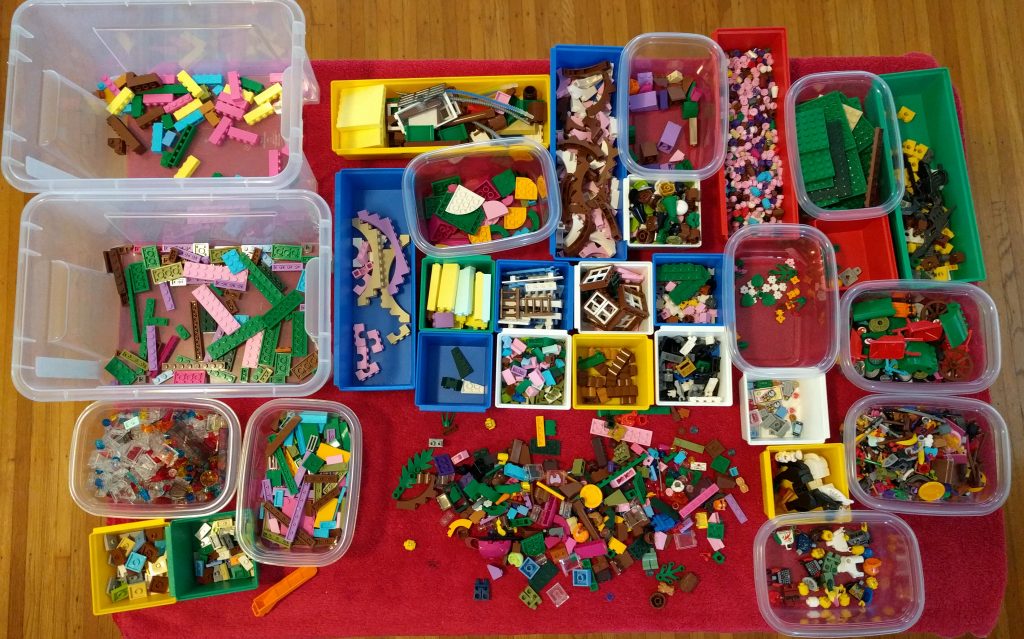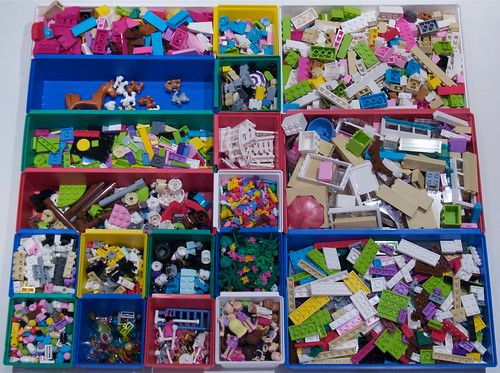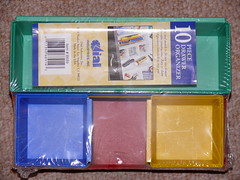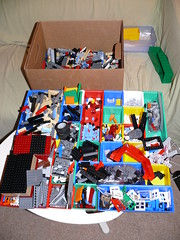I’m catching up on my backlog of unsorted elements that have been building up over the past few years, and wrote an article about the process. Check out Sorting Time to read about it.
Tag: sorting
Use a fry bagger to sort LEGO parts?
Use a fry bagger to put LEGO parts into Ziploc bags!
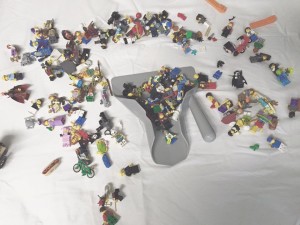
What a great idea! I saw this today on Facebook, posted by Soyary Sunthorn‎ in the AFOLs of FaceBook group. He got a fry bagger – a tool used in fast food restaurants to put french fries into the bags or other containers they are served in.
Since my storage system is primarily built around plastic bins filled with Ziploc bags, this should be a huge help when sorting and putting away bulk parts. I’m pretty sure this is the fry bagger in the photo, if you want to get one: New Star 37814 Polycarbonate Commercial French Fry Bagger, Right Handle I am planning to order one of these myself…
Full disclaimer: Amazon affiliate link above.
Colors and Sorting
I’ve been recently going through my LEGO collection adjusting some of the organization with respect to color. With all the new colors from the Friends sets coming in, I’ve been really at a loss to find an organization system that is consistent and clear, both while sorting and while looking for parts, and takes into account the vast differences in available parts across the color pallette.
Anyone who’s undertaken to sort LEGO has faced the age-old question – sort by color, or by shape? Like most people, my first attempt at sorting LEGO was by color, and like most people I immediately ran into some major drawbacks to that style of sorting:
- You can’t find the small pieces easily, which tend to drift to the bottom of the bin
- It’s a lot easier to find a red 1×4 among a pile of 1×4’s of all colors, than to find a 1×4 among a sea of red
- Tendency to make monochromatic MOCs, because it’s extra work to get parts of other colors
I didn’t stay with that sorting system for very long. For the past 10 years or so, I’ve been mainly sorting by shape, with color as a secondary sort parameter in some cases. Over the years I’ve evolved the following system:
- Bricks, plates (1x and 2x only), and tiles (except round ones): each color has its own container, and within that container each size is in a ziploc bag.
- Slopes: sorted into containers by angle (45, 33, etc.) and then ziploc bags within that container for each color. Corner and peak slopes are separated out from ordinary slopes as well.
- Everything else: all colors mixed together, sorted by shapes or categories of parts.
This has worked well as long as LEGO’s color pallette was fairly consistent. But in the past few years, especially with Friends coming out, I’ve had a hard time integrating new colors into my sorting system. The problem is that the new pastels, purple, etc. – as well as older colors such as the sand, medium, and dark colors – just don’t exist in the kinds of quantities that mainline/primary colors do. LEGO doesn’t make all sizes and shapes in each color, and I don’t have as many of them. So while it’s not hard to spot a purple part among a sea of same-shape/size parts of all colors, it can still take a fair amount of digging and raking through parts because there are so few of them. And since the new colors only include a small range of shapes/sizes, it’s hard to remember “Did LEGO make one of these in purple?”
So my thinking has evolved toward the conclusion that it’s better to have these rare colors separated out from the general population of my collection. If I’m going to build something out of purple parts, my options are more constrained by “what did LEGO make in this color?” than “can I find a specific part in this color?” anyway.
But then the question became, which colors get this treatment? Obviously colors I don’t have much of, such as Maersk blue or the new colors only found in Friends sets, do. But what about Orange? Lime? Sand green? Dark blue? Dark tan? These colors are a lot more common in recent sets, and LEGO have made a pretty complete pallette of them (at least compared to colors like purple), but still I don’t have that many and in some cases they are easily confused for colors such as grey or black.
I bet you can see where I’m going with this – I came to the realization that there are three types of color of LEGO parts.
- Main colors: white, black, light/dark stone grey, red, blue, yellow, tan, brown, dark red, green
- Intermediate colors: orange, lime, dark blue, dark green, medium blue, sand green
- Rare colors: purple, sand red, sand blue, sand green, Maersk blue, dark brown, dark tan, dark flesh/nougat, bright green, pastels, azure, teal, etc.
Main colors continue to be sorted as described above. I’ve been going through all my bins to pull out any Intermediate or Rare colors, however. The Intermediate colors get placed back in the bins where they were found, but in a separate ziploc bag. So I’m putting all those colors together in one bag in some cases, or where there is a lot of them into separate bags. For bricks and plates and tiles, they still get their own color bins, stored alongside the main color bins. Dark red has reached sufficient ubiquity to be counted as a Main Color, and some of the other dark or sand colors come close but didn’t quite make the cut.
But all the Rare color parts, regardless of what type or shape of part it is, get pulled out of the general population. These will be collected by color, and placed into a Rare Colors bin. All parts of the same color will go into one bag in most cases, except so far only Purple has enough parts to justify its own bin (because I bought a dozen #7591 Construct a Zurg sets on sale, so I have a lot of large purple parts). In most cases the parts are further divided into ziploc bags by type, and then those bags are placed together into a gallon ziploc bag.
I’ve gone through most of my bins and pulled out all the non-Main colors, and I’m feeling good about it so far. But I haven’t tried building anything with the Rare colors yet…
How do you tackle this issue?
Sorted Friends
First-stage sort of all the parts from all 14 of the Friends sets. In January I did a review of each of the sets in 14 days called “Fortnight of Friends” and these are the parts after dissassembling all the sets.
This first pass uses a bunch of my sorting bins to divide the parts into the following major categories. Each one will require its own second-stage sort (and perhaps in some cases, a third) before the parts reach their final resting place. These categories are totally arbitrary and seat-of-the-pants, and though they do roughly correlate to how I store the parts, really anything that reduces entropy is helpful.
Left column:
- Slopes, curved slopes, and anything that has a curved upper surface
- Animals
- Tiles
- Cylindrical parts and anything that has a curved side
- SNOT pieces and Technic parts
- Modified plates
- Wheels, fenders, and other car parts
- Small parts (1×1 rounds, jumper plates, grille tiles, Henrik/cheese slopes, etc.)
- Transparent parts
- Bars, antennae, flags, and controls
Middle column:
- Panels
- Printed parts and modified bricks (grille bricks, log bricks, bricks with clips on them, etc.)
- Fences
- Minifig accessories, including the new flowers (which should probably go under foliage) and bugs (which should probably go under animals)
- Foliage (plant parts and old style flowers)
- Minifig and minidoll body parts
Right column:
- Bricks
- Large parts (tall bricks, windows, doors, large detail parts, etc.)
- Plates
Now that I’ve finished the initial sort, I need to process these further.
I’m having trouble deciding how to integrate these into my collection. For bricks, plates, and tiles, I sort by color and then within the bin for each color I have Ziploc bags for each size, so I can put the new colors into their own little mini-categories, probably just one bag for each color… But for the other parts, I generally sort by type, and I’m worried the exotic rare colors will get lost among the ordinary ones… so should I mix them with the other colors and maybe never see them again? Or should I put all the purple pieces together regardless of shape?
This is a problem I’ve been facing for some time and I keep going back and forth on how to deal with it. Any new ideas out there?
Sorting bins
I recently bought some plastic bins at the local pharmacy (Longs Drugs, if you’re curious) and found them to be very useful for sorting LEGO parts.
These are sold for organizing small things in a drawer. My mom used to have something kind of like it to sort her silverware when I was a kid (though not the little ones). I’ve put them to use sorting LEGO. I connect them together in a big array on a small table, and then designate each one for a particular type of LEGO part.
It’s usually not possible to have enough bins for every possible category of LEGO part, so I do a multi-stage sort. First I sort into broad categories, which is what you see here, and then I take each category and do a secondary sort, and in some cases even tertiary, to their final categories.
How do you sort LEGO?

